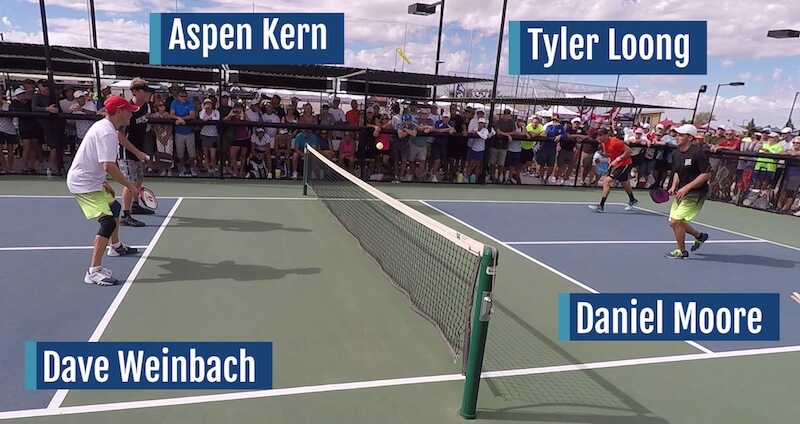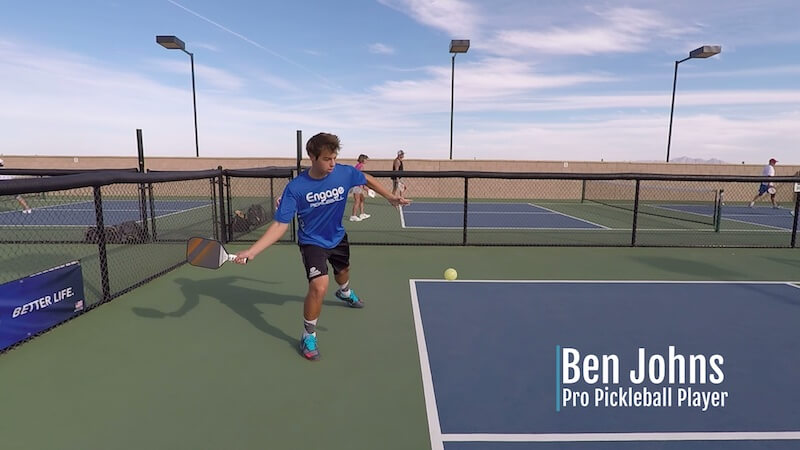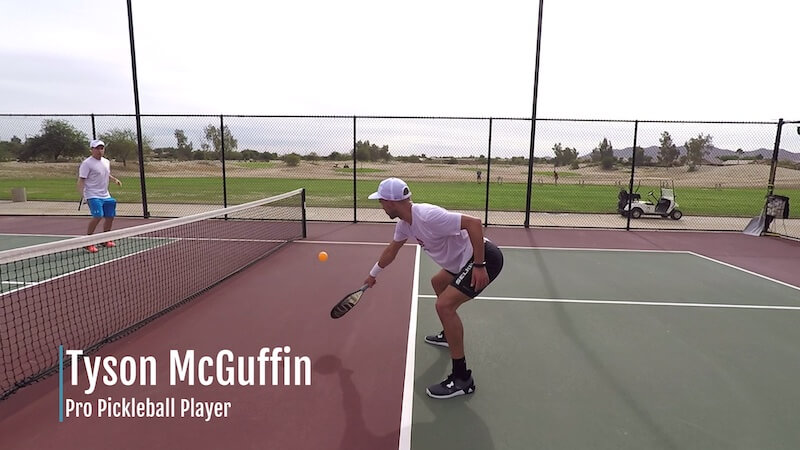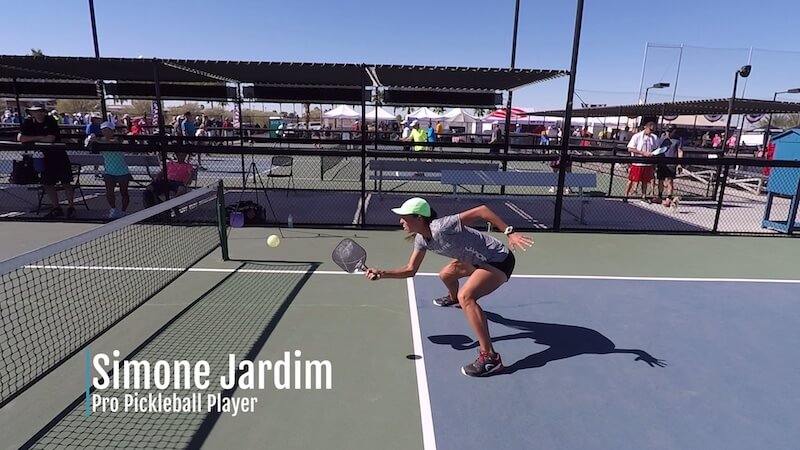We should all be watching pro pickleball matches to learn from the best right?
Yes! There’s definitely a lot to be learned from watching high level pickleball.
You can study their footwork, their stroke technique, their shot selection, their shot patterns, how they deal with adversity etc…
There’s a wealth of knowledge available to those who take the time to study pickleball matches.
And I don’t just mean watching only in real time, ooooing and ahhhhing at those unbelievable thread the needle winners or amazing defensive plays where the point was all but lost but they were able to scramble out some miracle gets, overcome the massive offensive onslaught and steal the point someway/somehow.
I mean watching in slo motion and breaking down the solid serve or the solid return or solid drop, dink etc… that isn’t fancy but is just sound and fundamental and shows up time and time again like a reliable soldier, point in and point out. The shots that get made every time and are at the very bedrock of winning pickleball strategy.
Those are the shots you absolutely need to own and rarely miss. That’s what you need to study about the pros. Mostly their impeccable execution of the basic Pickleball shots. That’s what actually makes pros pros. It’s not the flashy shots although that’s what sticks in our minds because they’re oh so sexy. Do they help, sure but by far and away the key difference maker is the rock solid fundamentals that don’t cost them any points because they make that shot every single time.
However, I can’t tell you how many times someone has come to me in a lesson and said that they want to work on something that they saw a pro do. Often it’s something on the fancier side. Like a forehand roll with heavy topspin or something like that.
They show me what it is and then explain to me how they think it happens as they’ve usually only ever seen it in real time.
The scary part is that they are often very far off in their understanding of what is actually happening and if we were to work on it the way they suggest, they’re going to end up developing a bad habit or worse….getting hurt.
The reason this happens is that just because something is happening right before your very eyes, the untrained eye doesn’t necessarily know how it’s happening. And if you haven’t seen it in slow motion, then you definitely can’t see what’s happening. Full speed swings are just too fast for the human eye to see.

So there’s that and there’s also the fact that I’ll watch them hit for a while and notice that they are missing routine returns, dinks etc…
A roll is not at all what is needed. But I get it…it’s fun. So we can take some time and get going on that and have some fun because that’s what pickleball is all about at the end of the day. And, then we should spend the majority of the rest of our time getting awesome at the fundamentals because that’s what leads to the wins and guess what…winning is super high on the list of fun. Am I right?
So the problem lies not only in the fact that very often, a player has no idea how a shot happens. That’s fair, it’s the reason they have come for a lesson, they know they need help with it.
But the bigger problem lies in the fact that many players think that the fancy shots and the thread the needle winners is a big part of what’s holding them back from being better than they are and winning on higher level courts.
That’s not it! That’s a misconception because as mentioned above, pros are pros at making fewer errors than most other players.
Arguably that’s the #1 thing that separates pros from the rest. They make very few errors.
And today, we’re going to dive in to 3 other big & common mistakes made by Rec players & really most players 4.0 and below. These 3 mistakes are what rec players “think” that pros are doing…that they should be doing too yet, really their focus should be entirely elsewhere. Cleaning up these 3 big mistakes will make a huge difference when applied to the game of most players.
Mistake #1 – Thinking Pros Swing “Hard”

Pros don’t swing “hard”, they swing fast and loose. They know how to transfer energy onto the ball with the right mechanics so that even though they hit it “hard” and it travels quickly through the court, it does not feel “hard” on their body.
When players try to simulate this and hit “hard”, they tend to tense up their whole body and swing stiffly. Incorrectly emulating the pros here is a fast way to get injured. It takes up a lot of energy, you’ll get tired quickly and your body won’t be happy with you.
Stiff and jerky motions are going to break down your body over time and may even ultimately sideline you from being able to play. Nobody wants that.
Also, you’ll have to spend a lot of time undoing those poor and painful mechanics. It’s best to get started on the right foot or course correct right away to avoid future issues.
Instead of trying to swing hard, focus on swinging relaxed and have a relaxed grip.
Be sure to start your swing early enough so that you can meet the ball in front where you can naturally and most efficiently transfer the most energy on it.
No matter if you’re hitting a forehand or a backhand, you need to turn those hips and shoulder so you can unwind your body into the shot, let that shoulder come all the way through. This is key, and the finishing touch is letting the forearm roll over, finishing the follow through and letting that off leg come through and around to finish the weight transfer and ultimately ready yourself for the next shot. If you emulate anything it should be these key factors to strong strokes that all pros have and not subtle style nuances of any one particle pro. Each person is unique. Everyone has different arm length and builds vs different torso length and build vs different hips etc… therefore, stylistically everyone’s shots will look different because of this but the core principles of a strong shot remain.
On the serve, groundstrokes and swinging volleys in particular, you need to let your arm swing and use it more like whip rather than a baseball bat or 2×4.
A whip is soft and flexible not rigid and stiff like a piece of wood.
The more you can learn to weild your arm like whip the faster you will be able to hit the ball.
On traditional volleys, drops and resets. You will hold yourself and your shot a little more firm and steady because you’re using mostly the oncoming energy and power on the shot provided by your opponent. But still, you don’t want to be tight and tense though your body is acting more like a rebounder on these shots so you’ll hold yourself more stable and any type of motion from your paddle will me more push like than swing like. You don’t need to produce a lot of power since it already exists. In fact, you may want to take pace off the shot such as for drops and resets so you will need to absorb some power with your paddle and body and in the case of a traditional volley, you just need to redirect the shot. No whip like motion needed on these shots. Less is more on these particular shots. Here the pros are trying to do the absolute least amount of movement with their motion as possible.
Mistake #2 – Thinking Pros go for winners

When you think back to matches that you watched or your own matches, what are the shots you remember most vividly? If you’re like most people, usually it’s those flashy winners.
What doesn’t get remembered is all those fundamental shots that were the setup for the flashy winner.
Pros don’t go for winning shots until they have earned that shot. And even then, they’re not usually going for a “winner”.
They are hitting it to a spot where they think their opponent will be in a very compromised position as they hit should they get to it. They are always ready for the next shot should that ball come back.
Sometimes it ends up being unreachable by the opponent and it becomes a winner.
They are actually “going” for a winner far less often than people realize. They mostly go for strong and well placed shots that end up being winners at times.
Unfortunately, far too many players are too quick to pull the trigger and go for a high risk shot without a strong setup.
They end up overhitting and the ball sails out or into the net.
I find that many players 4.0 and below are going for shots that are outside their skill set. If you can’t reliably make the shot your going for 8 or 9 out of 10 times on a regular basis then you shouldn’t be going for that shot. It’s too risky. It only takes one missed shot to lose the point and often many made shots to win the point. So the odds are against you in the long run if you’re playing too close to the edge of your skills. Clear the net with a little more margin than you think you need and aim a little more inside the line than you think you need. In my experience, many players are often going for too much. Think about it and be honest with yourself about the shots you can reliably make vs the ones you can’t and play accordingly. This adjustment alone will go a long way towards more wins for you.
Mistake #3 – Thinking Pros Have Perfect Technique

This one is a biggy and more tricky to understand.
There is no such thing as perfect technique, there is only the most efficient swing path and proper use of the kinetic chain relative to your body position, the type of ball you have received and the type of ball you want to send.
I know that was a mouthful but it boils down to this…
…are there certain checkpoints that most players with good strokes achieve on each stroke? Yes, they typically have a strong shoulder turn, no excessive backswing, contact point in front, get through the ball well etc…
And, they make micro adjustments on the fly depending on the ball they receive and what type of ball they want to send back.
They learned the proper basic “form” early in their playing career based on receiving gently fed or hit balls right in their strike zone and at a gentle speed.
Once they had that core form pretty much locked in, they adapted their technique as needed to be able to deal with a ball in any scenario.
And they did that incrementally over time, not all at once.
They ramped up the difficulty of the incoming shot as their skill improved and they worked on it and worked on it until they could deal with even the most difficult of incoming shots.
If you look around at the pros and their shots, yes there are key similarities but they all have different style to their shot that is unique to them. It’s their interpretation of “perfect technique”.
If you struggle with a certain type of ball, such as one coming in too deep, too hard, too low, with too much spin or whatever, then you need to dial those conditions down and figure out your technique in a less pressing scenario before you can move on to a more pressing scenario.
Many players want to practice at top speeds, top spins etc… That makes no sense if you’re missing every other ball or your technique is very forced and breaking down.
“Perfect Technique” is achieved when you can achieve the desired output you want on the ball as far as speed, spin, depth etc… with the least amount of effort.
You have to learn how to FEEL your shots and that is different for everyone so there is only the perfect technique for you. There is no universally perfect technique.
And that’s great news because that means there is the perfect stroke out there for you and only YOU. Nobody else can hit it like you and that opens up the doors for so much possibility in your game.
So get out there and find your best shot on every stroke. With enough concentrated effort over time, you’ll be amazed at what your game can evolve into.